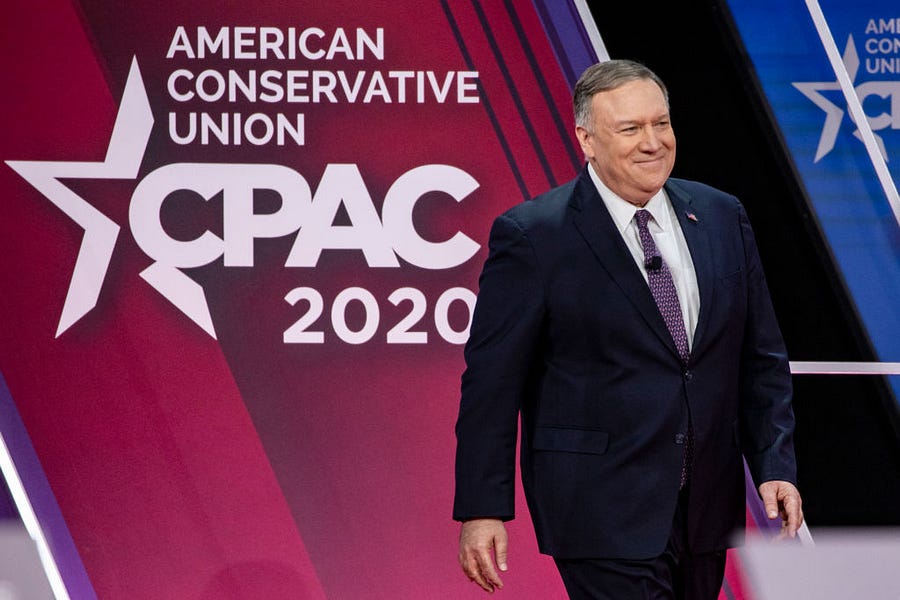The Conservative Political Action Conference is many things to many people. The annual gathering, which convened last week at the luxe Gaylord Convention Center outside D.C., is really about five different events rolled into one: a policy conference for wonks and the wonk-curious, a mixer for right-wing media types to hobnob and appear on each other’s shows, a networking space for Young Republicans to focus-test their handshakes, a Lollapalooza-for-boomers destination where faithful Fox watchers can see their TV favorites live, and a bankable moneymaker for its parent organization, the American Conservative Union.
On Friday, the conference’s marquee speaker was Secretary of State Mike Pompeo, who spoke one day after Vice President Pence and one day before President Trump. When Pompeo headed onto the main stage shortly after noon Friday, he was greeted by an appreciative crowd warmed up by the likes of Donald Trump Jr., his girlfriend and Fox alum Kimberly Guilfoyle, and “Blexit” activist Candace Owens.
“I am thrilled to be here at the largest conservative gathering in the country,” Pompeo beamed, “except every Trump rally.”
Pompeo’s joke gets at a real concern for CPAC these days. The conference has long been a place where the sometimes stodgy conservative movement can get its blood pumping a bit—an annual opportunity for activists to get whipped up anew about comprehensive immigration reform or Grover Norquist’s Taxpayer Protection Pledge. Along the way, it’s helped to turn the ACU into an engine of conservative fundraising.
These days, nobody’s accusing Republicans of being low-energy. If anything, they’ve now got the opposite problem: As Donald Trump has seized the reins, the GOP has become a party for political adrenaline junkies, with huge audiences for its loudest and fringiest voices. To maintain its brand identity, then, a place like CPAC faces the unenviable task of trying quietly to distance itself from some of the right’s foulest offenders—without losing its reputation as a place for fearless renegades who speak for the grassroots right.
The stated theme of this year’s CPAC was “America vs. Socialism,” a message intended to draw a stark contrast with the political left and to project a message of strong conservative unity. “It’s a very intended theme,” ACU Chairman Matt Schlapp said Thursday. “Our view is it’s not capitalism vs. socialism because socialism isn’t just about economics. Socialism, we believe, gets to the very core of violating the dignity of the individual human being that has God-given rights.”
It was also a theme perfectly in keeping with CPAC as it has always been. “We need to tell the story of empowerment and self-reliance, not dependence,” Rep. Dan Crenshaw said in one of the forum’s opening speeches. “We need to tell the story of freedom, not utopian collectivism. We need to tell the story that it is still okay to unapologetically love America.”
These sorts of unifying platitudes, which would have been as at home in the CPAC of 2014 as today, were par for the course for parts of the conference. When Heritage Foundation President Kay James glowed that President Trump had “embraced over 64 percent of The Heritage Foundation Mandate for Leadership” (even Ronald Reagan, she said, had accomplished only 49 percent!), it was like a glimpse into a universe where Ted Cruz became president in 2016.
But these nods to the CPAC structures of yesteryear were far from the norm. For the most part, CPAC’s coverage of and discussion of Trump wasn’t an assessment of how well he was stacking up to conservative standards—it was a testament to how thoroughly conservatives have molded their standards to him.
Plenty of time was set aside for President Trump’s personal grievances. Apart from socialism, the conference’s chief villain was Sen. Mitt Romney, who cast the lone GOP vote to convict Trump at his impeachment trial earlier this year and whom Schlapp publicly disinvited from CPAC shortly after that. And maybe not even socialism measured up: Sen. Bernie Sanders was not jeered with nearly as much relish as was Romney, whom speakers seemed to enjoy bringing up time and again. “Every time his name is mentioned you should respond that way,” Turning Point USA’s Charlie Kirk said during his Thursday speech, as the crowd broke into boos when he mentioned Romney. “He embodies the very same political class that President Trump ran against.” A conference-goer toting an “#ExpelRomneyFromGOP” sign fielded photo requests from other attendees all week long.
Others of the president’s personal foes got primetime slots as well. Peter Strzok, a former FBI agent who was removed from Robert Mueller’s Russia team for displaying anti-Trump animus, was the subject of an entire play on the main stage Thursday, in which actors portraying him and his FBI paramour Lisa Page read their anti-Trump text messages aloud, to polite laughs from the crowd.
Even that only scratched the surface: The origins of the Russia investigation were the subject of no fewer than six different main-stage discussions over the course of the conference. Previous staple issues—say, the national debt and federal deficit—went nearly untouched.
And, of course, there was the president himself. Trump brought down the packed house Saturday for nearly two hours, with extended and familiar riffs on his Democratic opponents, the Washington swamp, Romney, and various other obsessions.
***
All of which is to say: CPAC was not the kind of gathering you’d expect anyone to decry as not Trumpian enough.
Yet that was exactly the case made by the self-styled “dissident right” activists that gathered Friday night at a hotel just across the river in Arlington, for an event they called the inaugural America First PAC.
Those activists were headed up by the young reactionary podcaster Nick Fuentes, who became a flashpoint figure in conservative media last year after feuding with conservative writer Ben Shapiro and the aforementioned Charlie Kirk.
Fuentes and his fans, who call themselves “groypers,” are nationalists who support what they see as the true Trumpian project: defending white America’s cultural heritage, and halting the demographic “replacement” of white Americans by drastically curtailing both legal and illegal immigration into the United States. They disdain what they see as the warmed-over neoconservatism of most prominent Trump supporters, whom they deride as constituting “Conservative, Inc.” They’ve been condemned by pretty much everybody else as white nationalists and anti-Semites, although they reject both labels.
Each of the AFPAC organizers was a former CPAC attendee who had become, for one reason or another, too toxic to associate with, even for others on the fringey right. For Fuentes, it was his long history of half-ironic xenophobic agitation, including sneering jokes about the Holocaust and the El Paso mass shooting. For former Daily Caller writer Scott Greer, it was his history of writing pseudonymously for the alt-right website Radix. For Patrick Casey, it was his leadership of out-and-out white nationalist group Identity Evropa.
On Friday, the three were in D.C., along with longtime conservative blogger Michelle Malkin and about 100 fans, to protest CPAC’s freezing out of “dissident” nationalist voices. The event was planned secretly so nobody except “true believers” could sneak in; the location was only announced to pre-screened attendees the day of. “As far as I know, no journalists will be in attendance, no left-wing people, anything like that,” Fuentes said on his podcast days earlier. “So it should be comfortable and good and a fun time for everybody.”
In their speeches, which were streamed by tens of thousands of others online, they sneered at what they described as the cooptation of Trump’s movement by the same conservatives Trump defeated.
“When Donald Trump came down the escalator five years ago, his core message wasn’t that America needed a child tax credit or a better industrial policy subsidy. It was immigration,” Greer said, quoting at length from Trump’s “They’re not sending their best” speech the day he launched his campaign.
“But you would never know this if you listen to the people who call themselves Trumpists today. Depending on the source, you will hear that Trump just wanted to focus on jobs, regulations, tax cuts, or on some petty social issue. Their imagined Trumpism looks nothing like the agenda Trump won on.”
According to Greer, the most insidious force on the right wasn’t the anti-Trump holdouts, who were irrelevant anyway. Rather, it was the far more populous group of media forces and party types who had thrown themselves at Trump’s feet following his victory, but who were still trying to work quietly against the reactionary cultural message that Greer said had sent him to the White House in the first place.
“It’s inevitable that victors will force the defeated to bend the knee. It’s actually good that they’ve bent the knee. That’s what happens when you win. You want these people to come over and support you. The problem is, the defeated now speak as though they are the true victors. They believe that, actually, other people are bending the knee.”
Greer went on to jeer at length at other prominent nationalist Trump supporters by name. Israeli philosopher Yoram Hazony was “the dual citizen nationalist.” Sohrab Ahmari, an Iranian-American Catholic writer for the New York Post and First Things, was “a glorified Uber driver.”
When Fuentes took the mic, he immediately launched into the winking is-it-offensive-or-isn’t-it “humor” that is his calling card:
“When I’m devising these speeches, I want to have something fresh for all our groypers, who know all the relevant facts,” Fuentes said. “I want to have something fresh for everybody who knows what’s going on in the country—and who’s responsible.” He paused, leering, while the crowd tittered. “The Democrats. Democrats. What?” The audience laughed harder at the bait-and-switch.
Fuentes mocked people he says have told him he needs to tone down his message just a bit.
“I actually saw somebody the other day—I’m not going to reveal his ethnicity. I will not reveal his ethnicity!” Fuentes grinned. “But somebody came up to me the other day, and I get this all the time at CPAC. And I’ve told you, if you’ve been watching my show for a long time, I’ve been to CPAC three times, and every time I get this, when I go to Trump Hotel or everywhere else, it’s the same character—different people, but the same character.”
“They get their greasy finger and they put it in my lapel, and they say, ‘You know, you’ve got a lot of potential, and you’re gonna be a great ally, and I agree with most of what you say, but you’ve just gotta stop talking about Israel.”
The keynote speaker was Malkin, who has emerged in recent months as the groypers’ biggest previously mainstream cheerleader. Malkin, a onetime fixture at CPAC, spent the days leading up to the gathering denouncing its “ConInc gatekeepers” and trumpeting AFPAC as the true thinking patriot’s alternative.
“I rise tonight in defiant opposition to Conservatism Inc., and in unwavering support of America First,” Malkin said. “In the interest of full disclosure and transparency I must reveal to you that the number of donor class CEOs and philanthropists that are backing me is precisely zero.”
And Malkin mocked the idea that any of the groypers’ behavior could be construed as anti-Aemitic: “It’s anti-Semitic to mention George Soros’s billions. It’s anti-Semitic to question the Anti-Defamation League. It’s anti-Semitic to question whatever the precise number is of people who perished in World War II.”
***
It’s not hard to see why the powers that be at CPAC don’t want the groypers around. But siloing off a group from a movement is a little more difficult than simply not giving them tickets to an event. At CPAC, there were still plenty of people who run in both circles. No less a person than Ken Cuccinelli, Trump’s acting director of customs and immigration services, favorably mentioned Malkin while discussing an anti-sanctuary-cities rally she recently hosted in Maryland. Conspiracy theorist and InfoWars host Alex Jones appeared at a “Save the First Amendment” event alongside Fuentes in D.C. on Wednesday night; on Thursday, he made a grand splash among the media at CPAC, giving several interviews alongside Islamophobic provocateur and congressional candidate Laura Loomer just outside the main ballroom. Not only was Jones not turned away, video posted on social media seems to show ACU general counsel David Safavian welcoming him warmly and thanking him for being at the conference.
In one sense, this isn’t a new problem. The recent ascendance of proudly racialist and xenophobic movements on the online right have created a minefield through which the ACU has often blundered in recent years. In 2017, the most notable example was Milo Yiannopoulos, the vile rabble-rouser who was invited to CPAC as a keynote speaker—and promptly disinvited again after comments surfaced in which he spoke glowingly about the psychological benefits of ephebophilic relationships between young teens and older men. Last year, the flashpoint figure was Loomer, whose press pass was revoked after she spent her time at the event ambushing and heckling other reporters covering the event.
But while those bans were the subject of plenty of grousing from the people involved, this year was the first time we’ve seen much real collective organization on behalf of the dissidents. It’s made for some interesting gymnastics on the part of other figures on the bubble trying to figure out where in the dispute they stand.
Not even all of Jones’s fans, for instance, are thrilled by the Fuentes association.
“I don’t want people like that to connect with Alex. I don’t. I want to push them away,” Johnny Rice, a Maryland congressional candidate and InfoWars fan, told The Dispatch. “I worship a black Jew named Jesus. I’m a Zionist Jewish Christian. So I want people like that out. Because it makes Alex look bad. It makes InfoWars look bad when you promote those people.”
But others don’t see the harm. Loomer told The Dispatch that CPAC shouldn’t have banned the Fuentes clan. After all, the ACU had let in left-wing journalists who support antifa, and nothing the groypers had done was as bad as that.
“I’m a free-speech absolutist. And so I don’t have a problem with them having an event. I think CPAC should have allowed for everybody to attend. I don’t see why people are being kept out of a political event if their speech is peaceful and it’s nonviolent and they’re not inciting terrorist threats,” she said. “I like to see more speech, and I think that the way people come around to deciding what ideas suit them best is by diversity of opinion, and by having more opinions. And for a conservative conference, I think that they should be respecting free speech more and allow for that flow and debate to occur.”
Photograph of Mike Pompeo at CPAC by Samuel Corum/Getty Images.






Please note that we at The Dispatch hold ourselves, our work, and our commenters to a higher standard than other places on the internet. We welcome comments that foster genuine debate or discussion—including comments critical of us or our work—but responses that include ad hominem attacks on fellow Dispatch members or are intended to stoke fear and anger may be moderated.
With your membership, you only have the ability to comment on The Morning Dispatch articles. Consider upgrading to join the conversation everywhere.